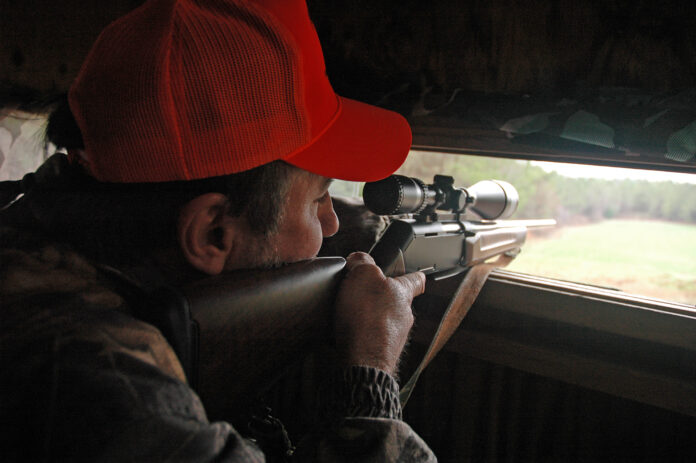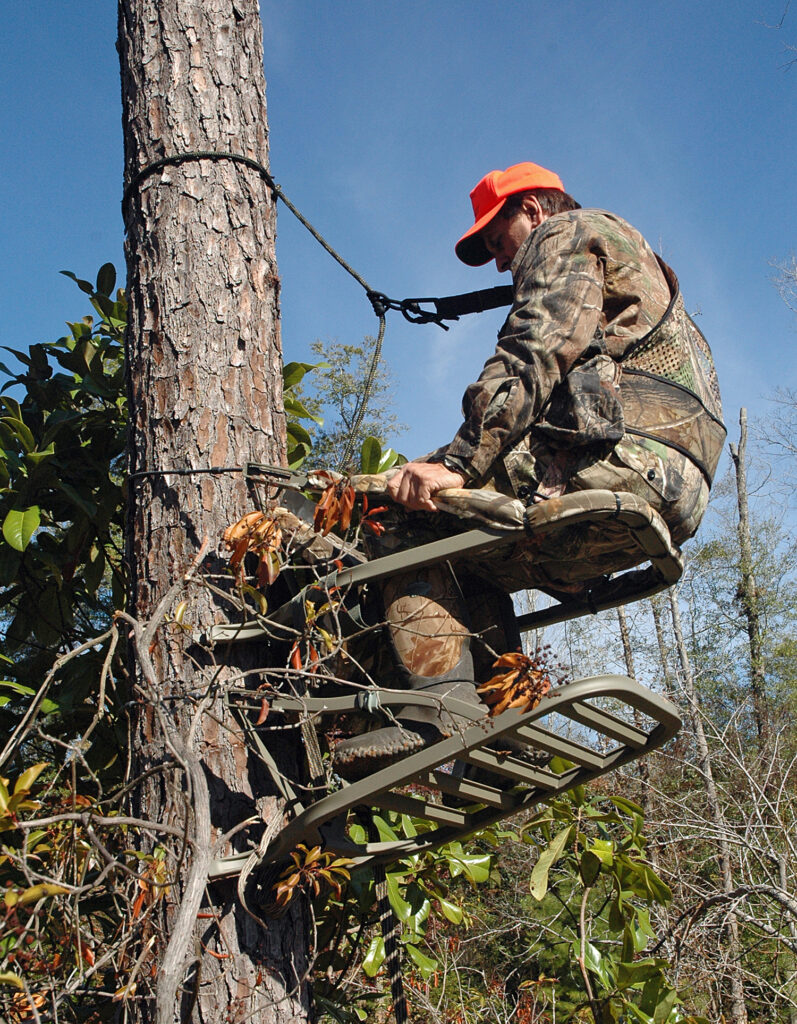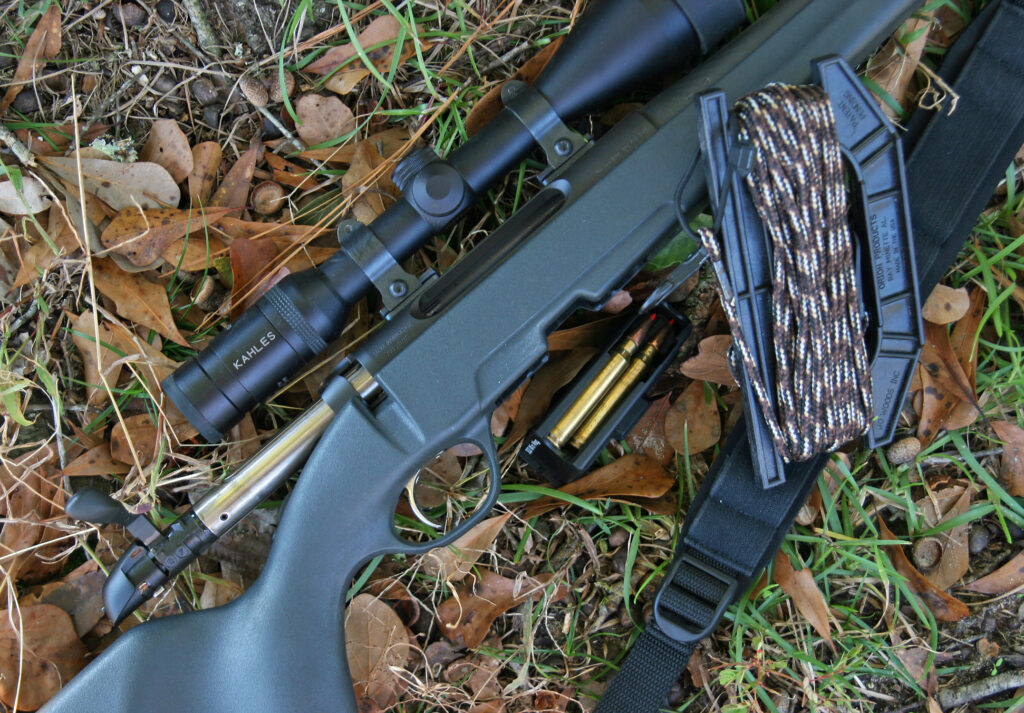
David Rainer, Alabama Department of Conservation and Natural Resources
Although the number of hunting accidents has held steady for the last several years, Captain Marisa Futral doesn’t want Alabama’s hunters to take anything for granted during the state’s lengthy hunting seasons.
Futral, the Alabama Wildlife and Freshwater Fisheries (WFF) Division’s Hunter Education Coordinator, said accidents for the past five years have averaged about 20 per hunting season, which she considers encouraging but not the ultimate goal.
Of the 22 accidents during the 2019-2020 season, WFF staff had reports of eight non-fatal firearms accidents, one fatal firearms accident, 10 non-fatal treestand accidents and three fatal treestand accidents.
“Of our non-fatal firearms accidents, half of them were self-inflicted,” Futral said. “The other half was failure to properly identify the target. The one fatality was failure to identify the target during turkey season. We really need to emphasize properly identifying the target before you put your finger on the trigger.
“And don’t get complacent. One of the non-fatal firearms accidents occurred when the hunter tripped and shot himself in the foot. Hunters need to be constantly aware of the muzzle direction of their firearm. Of the 13 treestand accidents, the victims either weren’t wearing safety harnesses or they weren’t attached to the tree. You need to be attached to the tree the entire time you’re off the ground.”
Futral said she can’t stress that last statement enough about being attached to the tree with a safety line from the time your feet leave the ground climbing until your feet touch the ground descending.
“A wide variety of accessories is available to ensure you are attached to the tree at all times,” she said. “Harnesses are much more comfortable than they were 10 years ago. They are easy to put on and are lightweight.”
Of the three treestand fatalities, Futral said the cause of one accident in Jackson County could not be determined. One fatal accident occurred in Fayette County when the victim fell out of his stand, and the other fatality occurred as the hunter was climbing down out of the stand.
Several non-fatal treestand accidents involved failures of straps or other parts of the treestand.
“Always check the condition of your treestands before you attempt to climb,” Futral said. “Treestands left out in the weather can deteriorate quickly.”
WFF Hunter Education urges all hunters to follow 11 guidelines for using a treestand safely:
- Always wear a safety harness, also known as a fall-arrest system, when you are in a treestand, as well as when climbing into or out of a treestand. Statistics show that the majority of treestand incidents occur while climbing in and out of a stand.
- A safety strap should be attached to the tree to prevent you from falling more than 12 inches.
- Always inspect the safety harness for signs of wear or damage before each use.
- Follow all manufacturer’s instructions for use of a safety harness and stand.
- Follow the three-point rule of treestand safety. Always have three points of contact to the steps or ladder before moving. This could be two arms and one leg holding and stepping on the ladder or one arm and two legs in contact with the ladder before moving. Be cautious that rain, frost, ice or snow can cause steps to become extremely slippery. Check the security of the step before placing your weight on it.
- Always hunt with a plan and, if possible, a buddy. Before you leave home, let others know your exact hunting location, when you plan to return and who is with you.
- Always carry emergency signal devices such as a cell phone, walkie-talkie, whistle, signal flare, PLD (personal locator device) and flashlight at all times and within reach even while you are suspended in your fall-arrest system. Watch for changing weather conditions. In the event of an incident, remain calm and seek help immediately.
- Always select the proper tree for use with your treestand. Select a live, straight tree that fits within the size limits recommended in your treestand’s instructions. Do not climb or place a treestand against a leaning tree.
- Never leave a treestand installed for more than two weeks since damage could result from changing weather conditions and/or from other factors not obvious with a visual inspection.
- Always use a haul line to pull up your gear and (unloaded) firearm or bow to your treestand once you have reached your desired hunting height. Never climb with anything in your hands or on your back. Prior to descending, lower your equipment on the opposite side of the tree.
- Always know your physical limitations. Don’t take chances. Do not climb when impaired by drugs, alcohol or if you’re sick or fatigued. If you start thinking about how high you are, stop climbing.
“It’s so easy to get complacent,” Futral said. “Your family wants you to come home from the hunt safely. Even if you’ve been doing this your whole life, take that extra minute to be safe. Make sure you’re hooked to the tree. Unload your firearm when you cross the fence. If you think it’ll be okay, ‘just this once.’ Don’t do it.”
The one firearm fatality occurred in Jefferson County when the hunter failed to properly identify the target during turkey season and shot a member of the hunting party.
Futral stresses the 10 commandments of firearms safety:
- Treat every firearm as if it is loaded.
- Control the muzzle of your firearm. Keep the barrel pointed in a safe direction. Never point a firearm at anything that you do not wish to shoot, and insist that your shooting and hunting companions do the same.
- Be sure of your target and beyond. Positively identify your target before you fire, and make sure no people, livestock, roads or buildings are beyond the target.
- Never shoot at water or a hard, flat surface. A ricocheting bullet cannot be controlled.
- Don’t use a scope for target identification; use binoculars.
- Never climb a tree, cross a fence or jump a ditch with a loaded firearm.
- Store guns and ammunition separately. Store firearms under lock and key, and use a gun case to transport firearms.
- Make sure your barrel and action are clear of all obstructions.
- Unload firearms when not in use. Never take someone else’s word that a firearm is unloaded. Check yourself.
- Avoid drugs and alcohol when hunting or shooting. Even some over-the-counter medicines can cause impairment.
Despite the accidents, hunting remains one of the safest recreational activities available. According to American Sports Data and the National Shooting Sports Foundation, hunting ranks lower than basketball, football, tennis, cheerleading, bicycling, golf, and even bowling in the total number of injuries per 100 participants.
Responsible hunters who mentor others in the aspects of safety, as well as the many volunteer hunter safety instructors around the state, have contributed to the high safety record for those who enjoy the great outdoors during the hunting seasons in Alabama.



















